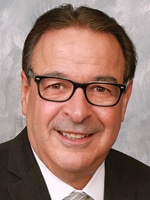Valerie Neff Newitt
September 2019—The FDA’s clearance this year of a second digital pathology system for primary diagnosis is likely to lead to lower costs and greater innovation and interoperability, say digital pathology advocates.
A multicenter study led the FDA in May to clear Leica Biosystems’ Aperio AT2 DX System for clinical diagnosis in the United States.
Laboratories in the U.S. have been slow to adopt digital pathology for primary diagnosis since the FDA’s approval in 2017 of Philips’ IntelliSite Pathology Solution, the first system to be cleared for primary diagnosis.

Dr. Asa
“And yet digital pathology has been around for almost 20 years,” says Sylvia Asa, MD, PhD, former chief of pathology of University Health Network (UHN), University of Toronto, where she now consults, and a consultant at University Hospitals of Cleveland. At UHN, she was an early adopter of digital pathology for primary diagnosis. “At the beginning there was extreme antipathy, intense doubt. People said, ‘You’re going to make mistakes. You’re going to get sued.’ There was no faith in the technology. But back then many people didn’t even have cell phones.” And times have changed, she notes, with the world becoming digital in the past two decades. “A traditionally conservative pathology approach has slowly moved forward. We all use electronic medical records and lab information systems and rely on IT. Now the challenge is to prove that digital pathology is actually better than glass slides.”
Asked what the differences are between the Philips and Leica systems (Dr. Asa is a Leica medical advisor and board member), she says: “Philips scanners are excellent, the image quality is superb, and the system offers a full package that, if you have no need for customization, works beautifully. However, in a big lab center with multiple applications, it’s a challenge because the Philips system doesn’t work well with other players. While Leica offers an open system [though cleared as a closed system for use in the U.S.], also with excellent slide quality, it is not quite as plug-and-play as the Philips system. So that also presents a challenge.”
Her point, she says, is that every vendor has strengths and weaknesses. “Some scanners on the market are really adaptable for special slide formats, such as large slides for whole mount sections, but neither Leica nor Philips accommodates those.” (CAP TODAY requested but was unable to obtain an interview with a Leica Biosystems representative.)
A second system cleared for primary diagnosis in the U.S., even with a limitation, is a plus for pathology, Dr. Asa says. “Like anything in life, more competitors in the field give the purchaser more opportunity to pick and choose what fits them best. And competition spurs innovation.”
Esther Abels, co-chair of the regulatory and standards task force of the Digital Pathology Association and DPA secretary, is vice president of regulatory and clinical affairs and strategic business development at PathAI in Boston. She was director of regulatory, clinical, and medical affairs at Philips Digital Pathology Solutions when its system was going through, and gained, FDA clearance. “Adoption is a slow process, unfortunately,” she says. “Most labs and pathologists are not picking it up quite yet because full digital pathology system integration is a demanding undertaking that requires a lot of investment, monetarily and procedurally.”
Still, the new clearance will have a positive effect on digital pathology, Abels says, though not necessarily in terms of immediate adoption. “I think it will build comfort and confidence around digital pathology, not just for users but for the FDA as well. As more people use digital pathology in clinical practice, the FDA becomes more comfortable easing some of its strict processes.”
Having reviewed the FDA summary files, Abels says both of the cleared systems are being verified and validated as closed systems, each composed of a scanner, viewing system, and monitor. “The FDA sees this as one entire system, one device, all locked into one approval. So labs and pathologists must have these three subsystems as a whole to replace their microscopes. And they have to test it end to end, from scanning all the way up to the display.” A second cleared system is a strong next step to changing all of that, she says.
“And I hope a third cleared system comes soon, because once the FDA sees three vendors can [reach clearance status], they may become more comfortable with breaking up the entire device into different subsystems, allowing interoperability between devices.” The FDA is now working with the Digital Pathology Association on artificial intelligence, including having discussions on whether more interoperability and more standardization can be achieved. “That will make a major impact on adoption,” Abels says.
Thomas W. Bauer, MD, PhD, pathologist-in-chief, Department of Pathology and Laboratory Medicine, Hospital for Special Surgery, New York, NY, has been a long-time user of digital pathology. Dr. Bauer was previously head of an “e-pathology” division at the Cleveland Clinic where the team validated the ability to interpret microscope slides for primary diagnosis, frozen sections, and consults, and demonstrated that the interpretation of whole slide images is not inferior to interpretation of microscope slides. The clearance of a second system is the start of competition among industry vendors, he says. “As additional scanners are approved, we would expect that competition in the industry would drive down costs. That’s really what this particular approval will mean to the everyday pathologist.”Dr. Bauer agrees that the latest clearance is a sign that “the FDA, a conservative institution, has recognized the safety and efficacy of digital imaging. This should increase confidence in the entire process among pathologists.”
Many pathologists, like Dr. Bauer, already have full confidence in digital pathology, in part because it has been used successfully for primary diagnosis for years outside the United States. “Those of us who have been to meetings and have heard early adopters from Europe and Canada have witnessed a lot of good reports. The data has been very enlightening and encouraging,” Dr. Bauer says.
Dr. Asa can speak directly to that. UHN, where she was head of pathology, was formed through the merger of three hospitals, two of which were across the street from one another and the other a mile away. “We built a consolidated department of pathology with all staff and equipment in one centralized location. But we had to have a pathologist for frozen sections at the more remote hospital,” she says. In 2004, she and colleagues tried to overcome the remote challenge by using a robotic microscope, but they found it slow and cumbersome. “So we went to whole slide imaging in 2006 when we recognized that this technology worked. We made the argument that a pathologist would look at the slides and if a slide was not suitable, a pathologist would make that call. Unlike the FDA, Canada was okay with that logic. So that was our starting point. We had a need, and digital pathology was the solution.”
It became the solution, too, for Ontario’s northernmost hospitals that do not have pathologists on site. “That was the start of our expansion. By 2008 the technology was used across northern Ontario, though only for urgent assessments.”
By 2011 technology had become available for massive throughput, so UHN started to use an Aperio digital pathology system for primary diagnosis. (Leica subsequently bought Aperio.) And it began using digital pathology to supply subspecialty pathologists to hospitals where all pathologists were generalists. “It meant we didn’t waste time with wrong diagnoses, didn’t waste money on the wrong drugs, and didn’t have patients sitting in hospital beds waiting for second opinions. All of these things affected the finances of the institution,” Dr. Asa says.
She and colleagues worked first with Aperio, then with Leica, on workflow and with their laboratory information system vendor (Cerner) to achieve a better and more streamlined process.
“Slides would get stained, come off the coverslipper, go to the scanner, get scanned, then integrated into the lab information system as a case,” she says. “The case was then sent automatically to the work list of the pathologist best able to handle that specific case. We didn’t need any more of a business case than this. We said, ‘Buy the equipment and we will get you faster, better, cheaper pathology.’”
Many pathology departments in the U.S. have a tougher time than their Canadian counterpart making a similarly compelling business case. Even in Canada, “the big challenge is to go to full primary diagnosis,” Dr. Asa says. “You have to be able to prove a benefit because the same pathologist, in the very same place, is going to read the slide whether it is glass or whole slide imaging. You’re swapping one technology for another, and that alone doesn’t make the business case.”
Terese
 CAP TODAY Pathology/Laboratory Medicine/Laboratory Management
CAP TODAY Pathology/Laboratory Medicine/Laboratory Management
